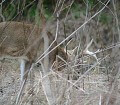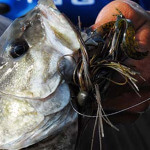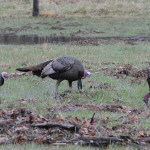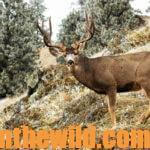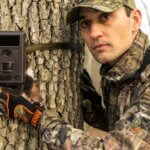John’s Note: Can you spot a turkey’s head as the bird comes through new foliage? Too, can you quickly and easily identify whether or not the bird has a beard? Can you see a deer fast and get off a clear shot before it vanishes in thick brush? While bowhunting with Travis Fryman, well-known professional baseball player and winner of several batting awards in the national leagues, I asked, “How do you see a baseball being thrown toward home plate at 90 mph?” Fryman answered, “I can see the ball and even the stitches on the ball and know which way those stitches are turning.” With that knowledge, in less than a fraction of a second, Fryman could determine when to swing his bat and where to hit the ball. Fryman had sharpened his vision skills through exercises. When a pro quarterback has called a pass play, he must be able to see each of his wide receivers as they run down and across the field and determine which receiver to throw the ball to complete the pass before he’s tackled. Too, the faster you can identify a turkey or a deer as it moves through the woods, the quicker you can mount your rifle or shotgun, aim and shoot accurately. There are ways you can speed up your reaction time by developing your vision skills. No matter how good someone’s basic visual abilities are, they can be enhanced. You can start now to improve your spring turkey season and fall and winter deer season success by developing your visual skills.
The effort to improve your ability to see and take deer in the woods should begin with a visit to a developmental optometrist. Some visual disabilities only can be alleviated by prescription lenses or vision therapy under a doctor’s directon.
Dr. Gary Etting (see Days 3 and 4) recommends these exercises that a hunter can perform at home and in the woods to enhance his hunting skills.
* Use an eye exercise to help you learn to assimilate visual information quickly. Use a Power Point presentation to flash pictures of game on a screen or a wall to train your eyes to see more quickly and in greater detail. In the woods, try to spot all the animals you pass, and notice the direction they are facing, their direction of flight and their distance from you. In a doctor’s office, an instrument called a tachistoscope is used to flash an image on a screen. The patient is asked to describe the picture after seeing it for only a fraction of a second.
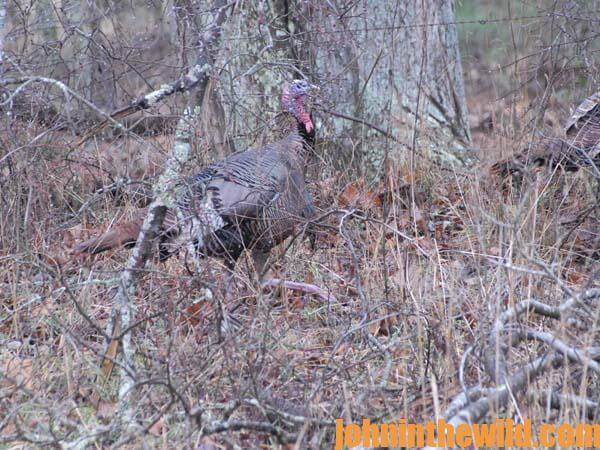 * Learn to change the focus of your eyes from iron sights to the target and vice versa within a fraction of a second. You can improve this skill at home by cutting a letter from a newspaper headline, and putting it up on a wall at eye level. Cut a paragraph out of the classified ads, and hold it in your hand. Move 10 or 12 feet away from the wall, hold the small print ad at eye level, and look back and forth between the letter on the wall and the ad in your hand, focusing clearly on each. Work to reduce your adjustment time.
* Learn to change the focus of your eyes from iron sights to the target and vice versa within a fraction of a second. You can improve this skill at home by cutting a letter from a newspaper headline, and putting it up on a wall at eye level. Cut a paragraph out of the classified ads, and hold it in your hand. Move 10 or 12 feet away from the wall, hold the small print ad at eye level, and look back and forth between the letter on the wall and the ad in your hand, focusing clearly on each. Work to reduce your adjustment time.
* Draw a circle the diameter of a riflescope on a clear piece of plastic. Look through the circle at the letter you’ve placed on the wall. The circle will become fuzzy. Then look back at the circle, and the letter will become fuzzy. Rapidly changing your point of focus will enable you to aim more quickly.
* Improve your perception afield by suspending a ball from the ceiling. Rotate your head, keeping your eye on the ball. This exercise will teach you to keep your eye on a standing deer or turkey, while you’re in motion. If you swing the same ball from side to side and rotate your head, while keeping your eye on the ball, you will train yourself to keep your eye on a deer or a turkey when both you and the animal are moving.
* Practice range estimation on walks. Quickly pick out an object in the distance or nearby, estimate the distance, and then pace it off, or use a range finder to check your estimate. You must know the actual length of your stride in inches. Don’t assume it is exactly a yard.
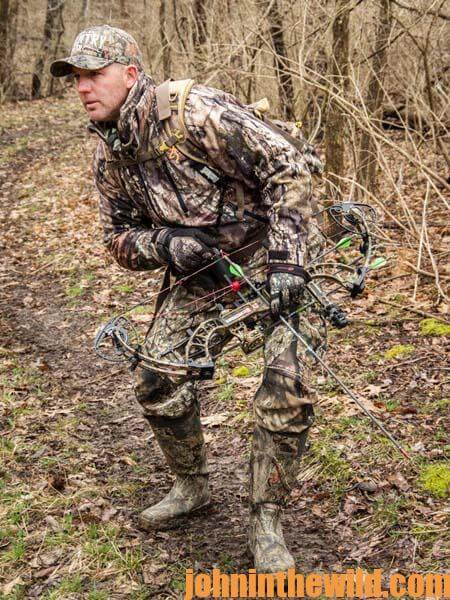 * Keep your eyes focused straight ahead, while walking down the street, and see how much your side vision can tell you about approaching pedestrians – where they are in relation to you and to other people on the street, what they’re wearing, and how they’re walking. Then, before hunting season begins, try this exercise in the field, with fellow hunters taking on the roles of approaching pedestrians. With repeated practice, you’ll learn to make better use of your peripheral vision, and you’ll maintain an awareness of what’s going on around you, while keeping your attention on the gunsight. This vision skill gives the hunter who’s swinging on game extra time to take accurate aim by helping him to spot a fast-moving target, before it moves into the line of fire.
* Keep your eyes focused straight ahead, while walking down the street, and see how much your side vision can tell you about approaching pedestrians – where they are in relation to you and to other people on the street, what they’re wearing, and how they’re walking. Then, before hunting season begins, try this exercise in the field, with fellow hunters taking on the roles of approaching pedestrians. With repeated practice, you’ll learn to make better use of your peripheral vision, and you’ll maintain an awareness of what’s going on around you, while keeping your attention on the gunsight. This vision skill gives the hunter who’s swinging on game extra time to take accurate aim by helping him to spot a fast-moving target, before it moves into the line of fire.
* Learn to overcome optical illusions in nature that can play havoc with your depth perception. Haze, for instance, makes things seem farther away than they really are. Or, an animal seen against a very-dark background will seem closer than it is.
* Use your range finder, or pace off the distance of your probable shots when preparing to sit on a stand in unfamiliar territory. Learn to gauge standard distances – such as 10 yards on a football field or the length of a football field – and apply your measure in the field. Learn to judge the size of animals accurately, and use size as a gauge of distance. Keep in mind that dim objects and dark ones seem farther away than they are.
 Quarterbacks, running backs, wide receivers and airplane pilots must quickly and instantly judge unknown distances and objects. The receivers need to know where 10, 20 and 30 yards are to be at the spot where the quarterback will throw the ball. The running backs must understand the distance they must travel from the line of scrimmage to the first down marker to enable them to give the maximum effort to gain a first down. The quarterback must know what 20 yards from the line of scrimmage looks like when he goes back to pass, because that’s the spot he’ll throw the ball to before the receiver reaches that spot. Airplane pilots must be able to identify enemy planes at a glance. These calculations and distance measurements are necessary too for a hunter to aim and shoot accurately in the field.
Quarterbacks, running backs, wide receivers and airplane pilots must quickly and instantly judge unknown distances and objects. The receivers need to know where 10, 20 and 30 yards are to be at the spot where the quarterback will throw the ball. The running backs must understand the distance they must travel from the line of scrimmage to the first down marker to enable them to give the maximum effort to gain a first down. The quarterback must know what 20 yards from the line of scrimmage looks like when he goes back to pass, because that’s the spot he’ll throw the ball to before the receiver reaches that spot. Airplane pilots must be able to identify enemy planes at a glance. These calculations and distance measurements are necessary too for a hunter to aim and shoot accurately in the field.
To get John’s book, “The Turkey Gobbler Getter Manual,” for free, go to www.johninthewild.com/free-books to download.
To learn more about John E. Phillips’ eBooks and print books on hunting turkeys and deer, click here.

